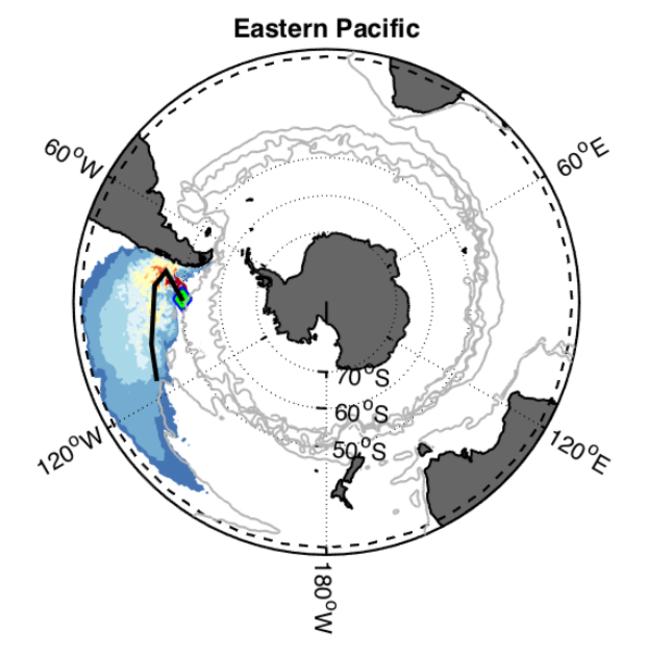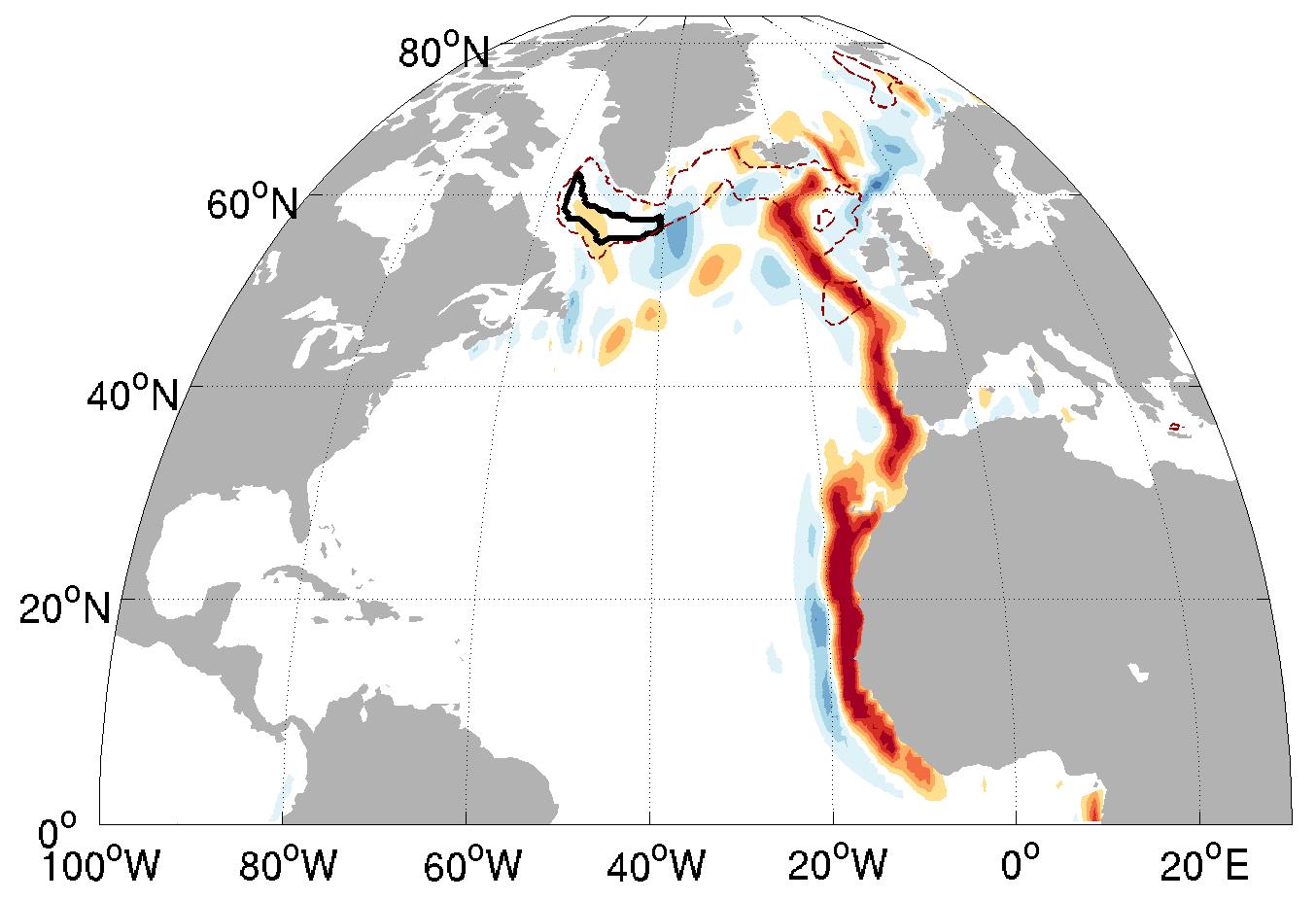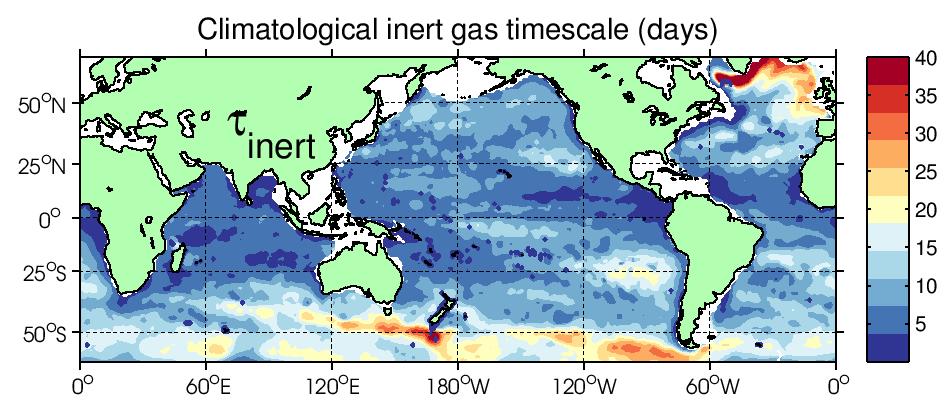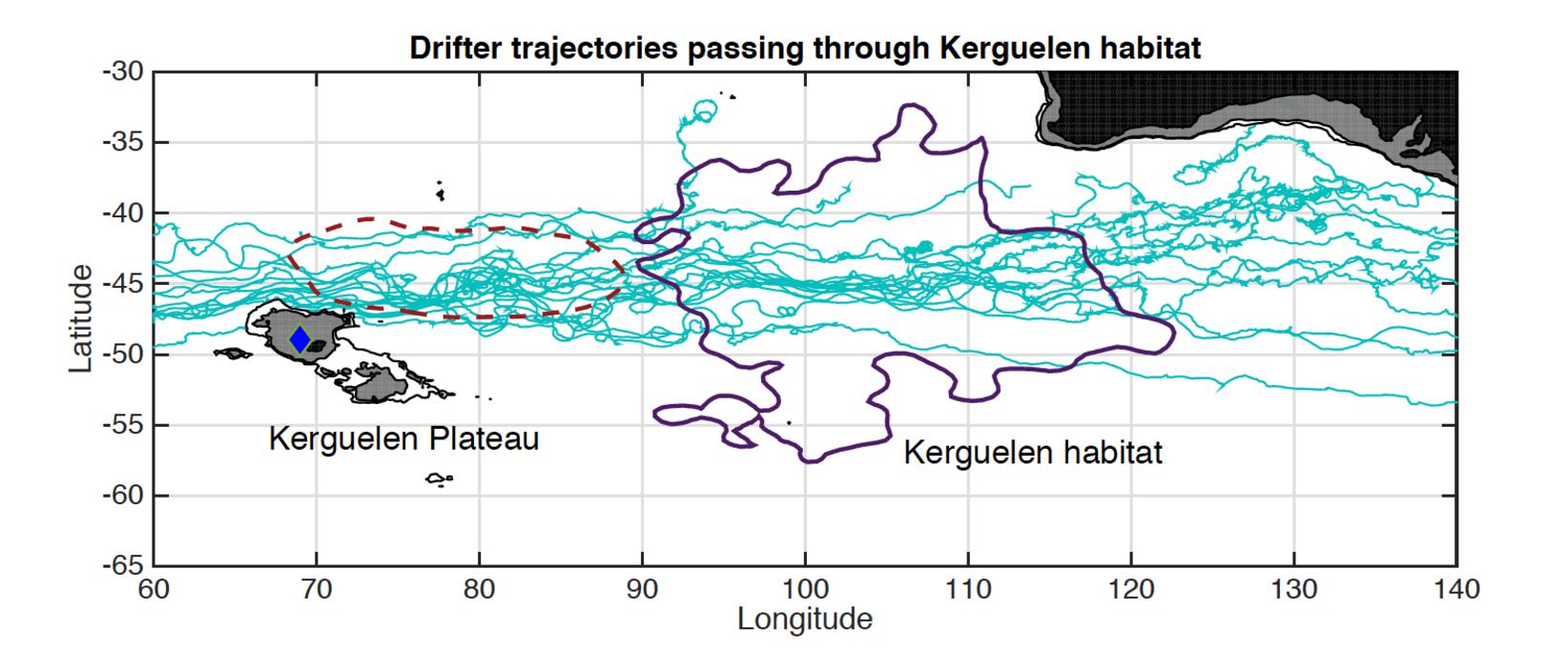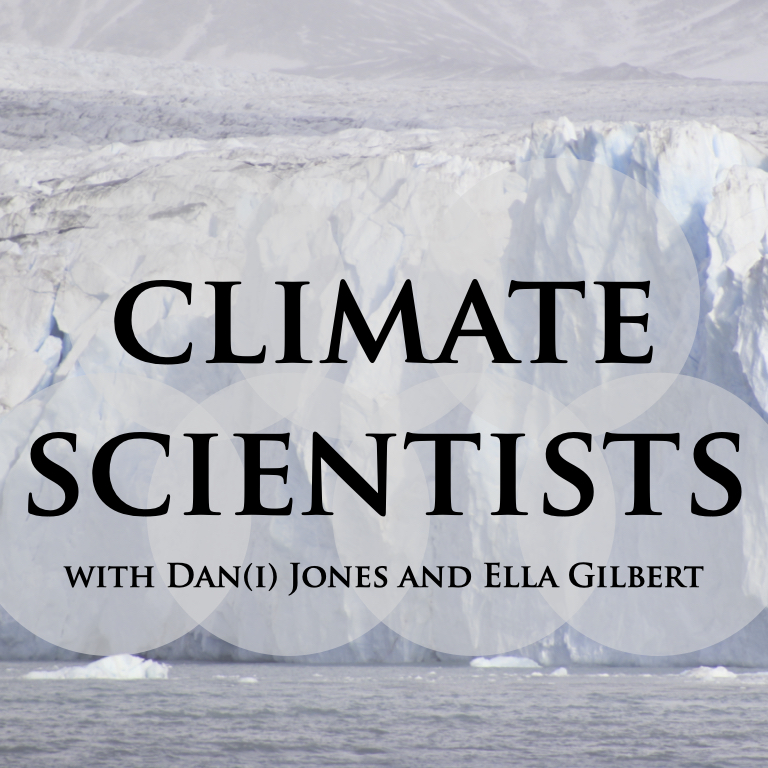Publications
Featured publications
Review paper on Southern Ocean ventilation
Morrison, A., D. Waugh, A. Hogg, D.C.
Jones, and R. Abernathey (2022), Ventilation
of the Southern Ocean pycnocline. Annual Review of Marine
Science, 14:1, 10.1146/annurev-marine-010419-011012.
Summary: a review paper on Southern Ocean
ventilation
Review paper on machine learning in oceanography
Sonnewald, M., R. Leguensat, D.C.
Jones, P. Dueben, J. Brajard, and V. Balaji (2021). Bridging observations,
theory and numerical simulation of the ocean using Machine Learning,
Environmental Research Letters, 16 073008,
https://doi.org/10.1088/1748-9326/ac0eb0. Summary: a
review paper on machine learning in oceanography
Using machine learning to define fronts
Thomas, S.D.A., D.C. Jones, A. Faul, E.
Mackie, and E. Pauthenet (2021). Defining Southern Ocean
fronts using unsupervised classification, Ocean Science,
17, 1545-1562, https://doi.org/10.5194/os-17-1545-2021.
Summary: we challenge a dominant view of fronts by
using an unsupervised classification technique to define them
IceNet: an AI-driven Arctic sea ice prediction system
Andersson, T., J.S. Hosking, M. Perez-Ortiz, B. Paige, A. Elliott, C.
Russell, S. Law, D.C. Jones, J. Wilkinson,
T. Phillips, J. Byrne, S. Tietsche, B.B. Sarojini, E.
Blanchard-Wrigglesworth, Y. Aksenov, R. Downie, and E. Shuckburgh
(2021). Seasonal
Arctic sea ice forecasting with probabilistic deep learning,
Nature Communications, 12, 5124.
https://doi.org/10.1038/s41467-021-25257-4. Summary: on
IceNet, a new AI-driven method for sea ice forecasts
Boland, E., Jones, D.C., Meijers, A. J.
S., Forget, G., and Josey, S. A. (2021). Local and remote influences
on the heat content of Southern Ocean mode water formation regions.
Journal of Geophysical Research: Oceans, 126, e2020JC016585.
https://doi.org/10.1029/2020JC016585. Summary: an
adjoint sensitivity paper exploring what affects heat content in surface
mode water pools
Twelves, A., Goldberg, D. N., Henley, S. F., Mazloff, M. R., and
Jones, D.C. (2021), Self-shading and meltwater
spreading control the transition from light to iron limitation in an
Antarctic coastal polynya. Journal of Geophysical Research:
Oceans, 126, e2020JC016636.
https://doi.org/10.1029/2020JC016636
Jones, D.C., Ceia, F.R., Murphy, E.,
Delord, K., Furness, R.W., Verdy, A., Mazloff, M., Phillips, R.A.,
Sagar, P.M., Sallee, J.-B., Schreiber, B., Thompson, D.R., Torres, L.G.,
Underwood, P.J., Weimerskirch, H. and Xavier, J.C. (2021). Untangling local and remote
influences in two major petrel habitats in the oligotrophic Southern
Ocean. Global Change Biology, 27, 5773-5785.
https://doi.org/10.1111/gcb.15839
Jones, D.C., E. Boland, A.J. Meijers,
G. Forget, S. Josey, J. Sallee, and E. Shuckburgh (2020), The Sensitivity of
Southeast Pacific Heat Distribution to Local and Remote Changes in Ocean
Properties. Journal of Physical Oceanography, 50, 773-790,
https://doi.org/10.1175/JPO-D-19-0155.1
Paper on what controls the heat distribution in the Southern Ocean:
D.C. Jones, E. Boland, A. Meijers, G. Forget, S. Josey, J-B. Sallee, and E. Shuckburgh (2019),
Heat distribution in the Southeast Pacific is only weakly sensitive to high‐latitude heat flux and wind stress,
Journal of Geophysical Research - Oceans, 124, https://doi.org/10.1029/2019JC015460. Article /
Preprint
Description: Using a numerical modelling technique called adjoint modelling, we examined the factors that control the heat distribution the recently ventilated Southeast Pacific sector of the Southern Ocean.
We were somewhat surprised to find that the distribution was only weakly sensitive to high-latitude atmospheric processes.
Our paper on machine learning applied to Argo float data:
D.C. Jones, H.J. Holt*, A. Meijers, and E. Shuckburgh (2019),
Unsupervised clustering of Southern Ocean Argo float profiles,
Journal of Geophysical Research - Oceans, https://doi.org/10.1029/2018JC014629. Article /
Preprint
Description: We used unsupervised classification, a machine learning technique, to objectively identify groups of Southern Ocean temperature measurements with similar vertical structures.
This approach may be useful for automatically locating structures in climate data, which is important given the ever increasing volume of observational and model data.
Our paper on a connection between the Labrador Sea and West Africa:
D.C. Jones, G. Forget, B. Sinha, S. Josey, E. Boland, A. Meijers, and E. Shuckburgh (2018),
Local and remote influences on the heat content of the Labrador Sea: an adjoint sensitivity study,
Journal of Geophysical Research - Oceans, 123. doi:10.1002/2018JC013774.
Article /
Preprint /
Blog Post
Description: Using a numerical modelling technique called adjoint modelling, we examined the factors that control the heat content of the climatically-important Labrador Sea, which is a site of heat and carbon exchange between the surface and the deep interior ocean.
We found and tested an unexpected connection between Labrador Sea heat content and winds along the remote West African shelf.
Our paper on mode water export:
D.C. Jones, A. Meijers, E. Shuckburgh, J.-B. Sallee, P. Haynes, E.K. McAufield, and M.R. Mazloff (2016),
How does Subantarctic Mode Water ventilate the Southern Hemisphere subtropics?,
Journal of Geophysical Research - Oceans, 121, doi:10.1002/2016JC011680.
Article
Description: Using a high-resolution numerical model of the Southern Ocean, we identified and examined a relatively efficient pathway for transporting heat and carbon from the surface ocean into the interior ocean, where it can potentially be sequestered for many decades to centuries.
Our paper on the long-term response of the SO to wind stress changes:
D.C. Jones, T. Ito, and N.S. Lovenduski (2011),
The transient response of the Southern Ocean pycnocline to changing atmospheric winds,
Geophysical Research Letters, 38, L15604, doi:10.1029/2011GL048145.
Article
Description: Observations from the last several decades show a significant increase in the strength of westerly winds over the Southern Ocean, but an appreciable change in the tilt of constant density surfaces (isopycnals) has not yet been detected there.
We used an idealized numerical model to demonstrate that it may take many decades to centuries for Southern Ocean density structures to respond to changes in wind stress, due to coupling with the rest of the ocean.
Other selected publications
Sanders, R. N. C., D.C. Jones, S. Josey, B. Sinha, and G. Forget, Causes of the 2015 North Atlantic cold anomaly in the ECCOv4 state estimates, Ocean Science Discussions [preprint], https://doi.org/10.5194/os-2022-10, in review, 2022
D. Duncan, P. Eriksson, S. Pfreundschuh, C. Klepp, and D.C. Jones (2019),
On the distinctiveness of observed oceanic raindrop distributions,
Atmospheric Chemistry and Physics, 19 (10), 6969-6984, doi:10.5194/acp-19-6969-2019, Article
N. Mackay, J.R. Ledwell, M.-J. Messias, A. Naveira-Garabato, J.A. Brearley, A. Meijers, D.C. Jones, and A.J. Watson (2018),
Diapycnal mixing in the Southern Ocean diagnosed using the DIMES tracer and realistic velocity fields,
Journal of Geophysical Research - Oceans, 123. https://doi.org/10.1002/2017JC013536.
Article
T. Dittmar, A. Stubbins, T. Ito, and D.C. Jones (2017), Comment on "Dissolved organic sulfur in the ocean: Biogeochemistry of a petagram inventory",
Science, 356 (6340), 813, doi:10.1126/science.aam6039.
Article
Hammond, M. D.* and Jones, D. C. (2016),
Freshwater flux from ice sheet melting and iceberg calving in the Southern Ocean,
Geoscience Data Journal, 3: 60-62, doi:10.1002/gdj3.43.
Article /
Dataset
Meijers, A., Meredith, M.P., Abrahamsen, E.P., Morales Maqueda, M.A., Jones, D.C., and Naveira Garabato, A.C. (2016),
Wind-driven export of Weddell Sea slope water.
Journal of Geophysical Research - Oceans, 121, doi:10.1002/2016JC011757.
Article.
D.C. Jones, T. Ito, T. Birner, A. Klocker, and D. Munday (2015),
Planetary-geometric constraints on isopycnal slope in the Southern Ocean,
Journal of Physical Oceanography, 45 (12), 2991-3004, doi:10.1175/JPO-D-15-0034.1.
Article
Ceia, F. R., J. Ramos, R. Phillips, Y. Cherel, D.C. Jones, R. Vieira, and J. Xavier (2015), Analysis of stable isotope ratios in blood of tracked wandering
albatrosses fails to distinguish a �13C gradient within their winter foraging areas in the southwest Atlantic Ocean, Rapid Communications in Mass Spectrometry,
29, 2328-2336, doi:10.1002/rcm.7401.
Article
Xavier, J., B. Raymond, D.C. Jones, and H. Gri�ths (2015), Biogeography of cephalopods in the Southern Ocean using habitat suitability prediction models,
Ecosystems, doi:10.1007/s10021-015-9926-1.
Article
D.C. Jones, T. Ito, Y. Takano, and W-C. Hsu (2014),
Spatial and seasonal variability of the air-sea equilibration timescale of carbon dioxide,
Global Biogeochemical Cycles, 28, 1163-1178, doi:10.1002/2014GB004813.
Article
* = student

